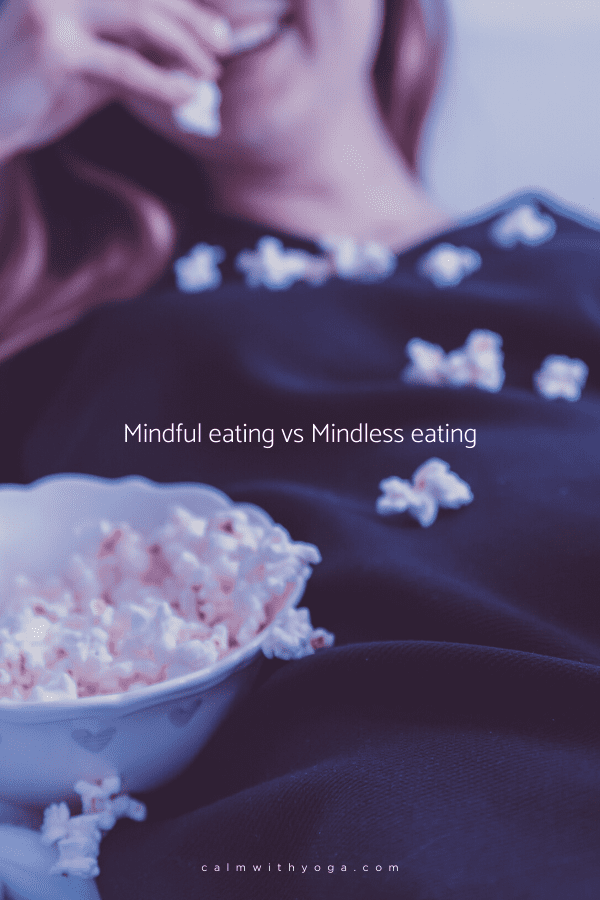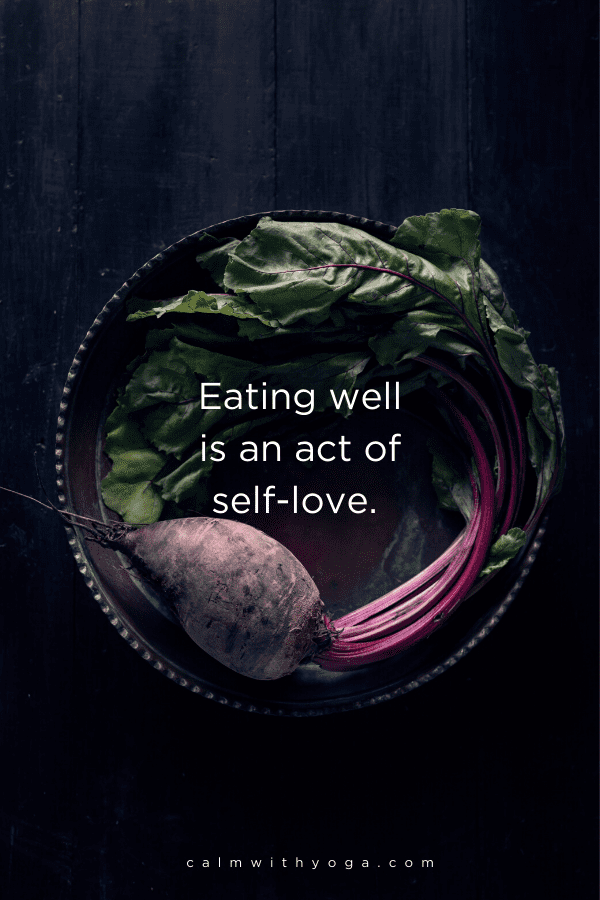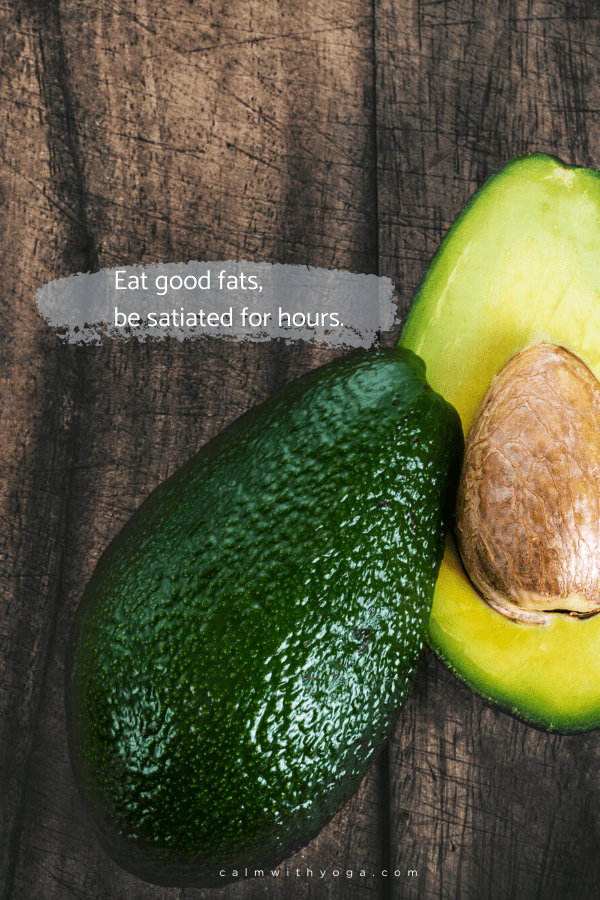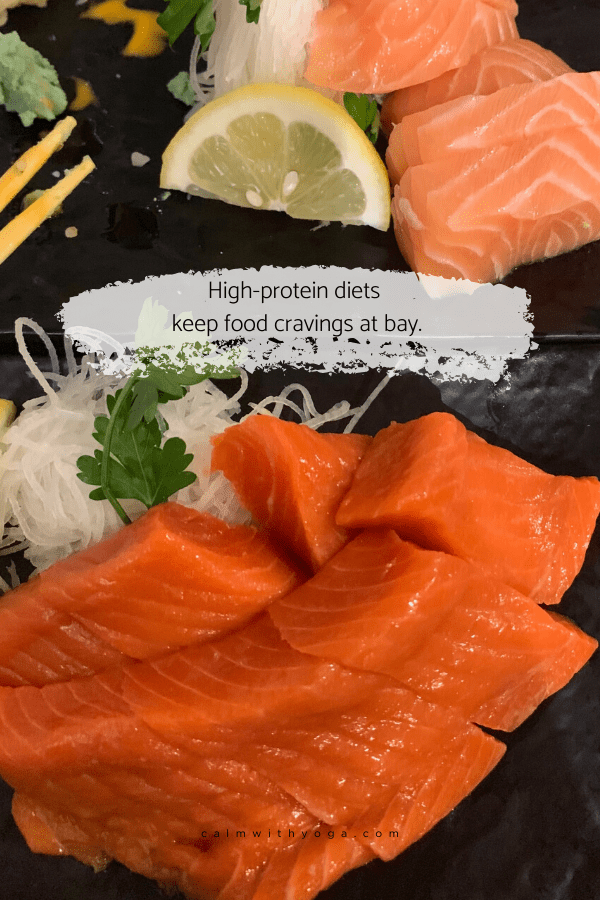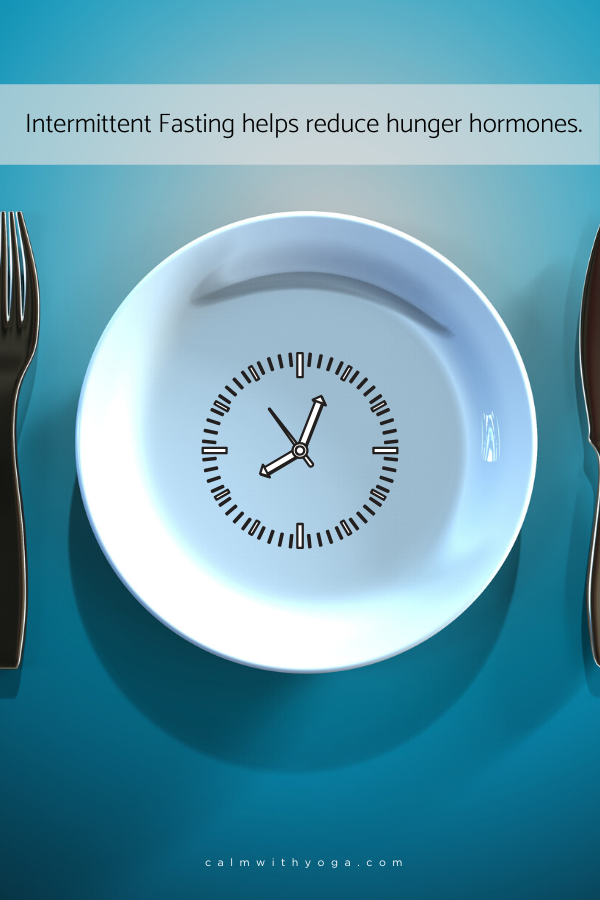– Geneen Roth, author It may also have to do with your food choices and eating habits. Or there might be an underlying mental-emotional component to the physical sensations. It can be frustrating to feel like you can’t control your hunger, so what can you do to rebalance your body’s satiety response? Here are 12 proven tips based on the yogic approach to eating, Buddhist mindfulness principles, and functional nutrition…
1- Mindful Eating (Intuitive Eating)
Mindful eating is based on the Buddhist practice of mindfulness – paying attention in a particular way to what is happening in the present moment without having to change it or judge it. Over time and with constant practice, mindful eating can also be considered intuitive eating or healthy eating because we become very present and attuned to the eating experience and our senses. We are able to connect to our bodies and psyche in a deeper way, so we can better listen to our bodies’ cues for hunger, fullness, and whatever cravings come about. Mindful eating practices such as eating slowly and being present to the sensation of when you chew can help to reduce overeating and endless dieting. It can also help you make better food choices which can increase feelings of fullness. Try to engage all of your senses and offer up your full attention during your next meal and see how you go.
2- Self-Inquiry (Svadhyaya)
Svadhyaya is the yogic principle of self-study, self-inquiry, self-awareness, and introspection. You can apply this principle to your eating habits by simply observing yourself in relationship to food. Self-inquiry is related to mindfulness so both go hand in hand. Pay attention to your mental/emotional state before eating. Bring awareness to your food choices. Notice how you eat. Notice what you crave. Ask yourself questions to uncover if there are any underlying emotional triggers. Become aware of your body’s hunger cues and feelings of fullness. What do the hunger pangs feel like? Your body will tell you when it’s a physical hunger pang or an emotional hunger pang that’s requiring your attention. What does fullness feel like in your body? Your body is wise and intelligent so learn to listen to it and trust it.
3- Non-greediness (Aparigraha)
Aparigraha is the yogic principle of non-greediness and non-attachment. Aparigraha helps us transform a ‘lack mentality’ and fears of not having enough. This is what leads to compulsive behaviors and cravings. According to yogic philosophy, compulsive craving is one of the five afflictions and obstacles (kleshas) to ascending to higher levels of awareness and consciousness. These afflictions are the source of pain and suffering. In Buddhism, this is referred to as our ‘hungry ghosts.’ Psychologist and Buddhist teacher Tara Brach explains it like this: Watch your hungry ghosts during meal times and when you’re portioning. Not only are we caught in the pain of craving, but we are also condemning ourselves for it. When we are stuck in this craving, shame, and addictive looping, we cannot be present for our moments. Always wanting something different, we miss out on the life that is right here.” (1) Observe without judgment and slowly whatever lack mentality you have towards food can transform into contentment and gratitude…
4- Contentment (Santosha)
Santosha is the yogic practice of contentment. This is what can transform hungry ghosts and lack mentality into “enoughness” and a sense of inner confidence and sufficiency. One unique way to practice Santosha in terms of our nutrition is by adopting the Japanese habit of Hara Hachi Bu. Hara Hachi Bu means stop eating when you’re 80% full. In the West, we tend to stop eating when we’re full, but in Japan, the custom is to stop eating when you’re no longer hungry. By eating when you’re no longer hungry you’re training your body to seek contentment and not excess. Plus, this means you’ll ingest fewer calories which trains your digestive system to reset and subsist on less without feeling intense hunger.
5- Drink a 400 ml glass of water 30 minutes before your meals (Saucha)
Saucha is the yogic principle of cleanliness and purity. Water is the universal element that represents both. 60% of the human body is made up of water, and yet, most of us simply don’t drink enough water on a daily basis. A chronic state of dehydration, even if it’s mild, can create symptoms that mimic hunger pangs. This means you may “feel” hungry but really be thirsty. According to recent studies, it’s estimated that 37% of people mistake hunger for thirst. (2) Make it a habit to drink a glass of water 30 minutes before each meal and consume at least 1/5-2 liters of water daily.
6- Get your beauty sleep (Yoga Nidra)
Not getting enough sleep will mess with your hunger hormones and cause you to be hungrier and eat more. One study found that just one single night of sleep deprivation causes an increase in levels of the hunger hormone ghrelin, as well as a decrease in the fullness hormone leptin. (3) A single night of poor sleep also causes blood sugar imbalances and insulin sensitivity, which can make you crave rich foods and gain weight more easily. (4) If you have trouble going to sleep or staying asleep the practice of Yoga Nidra (yogic sleep) can help activate your nervous system’s relaxation response so you can recover. (5)
7- Load up on fiber
Fiber is filling and isn’t easily broken down so it helps slow digestion down. Studies have found that high-fiber diets can have an appetite suppressant effect. (6) Be sure to fill up 65-75% of your plate with a wide range of veggies, nuts, and seeds to get your daily dose of fiber.
8- Reduce your carb intake
A high-carb diet is one of the worse culprits for chronic hunger because carbs are digested quickly and don’t offer much nutritional density. This is especially true if you’re consuming processed carbs like bread, crackers, or cereal. If you want to feel full for longer, and want to ditch the energy crash accompanied by eating carbs then drastically reduce your consumption. Opt for unprocessed carbs that offer more nutritional value such as root vegetables and squashes to control hunger.
9- Ditch “low-fat” for “high-fat”
One of the best ways to curb hunger is to increase your consumption of high-quality fats such as avocado (also high fiber so double whammy), olive oil, coconut oil, egg yolks, salmon, salmon roe, avocado oil, MCT (medium-chain triglyceride) oil, hemps seeds, chia seeds, and tahini. These foods can feel indulgent and satisfying while also being extremely nourishing and healthy dense foods. A study review found that people can last longer periods of hunger and feel more satiated when they consume a high-fat, low-carb diet. (7)
10- Go high-protein
A high-protein, high-fat diet is a winning combo if you want to feel full and stay full for longer and support your weight loss efforts. Loading up on high-quality protein such as collagen peptides, wild-caught low mercury fish like salmon and sardines, organic free-range chicken, or grass-fed beef can help you avoid overeating or eating things that won’t satiate you. It can also help to keep blood sugar balanced and food cravings at bay.
11- Try intermittent fasting (time-restricted eating)
A new study published in the Obesity journal found that time-restricted eating can help to reduce appetite. (8) Researchers found that eating within a six-hour window (from 8 am – 2 pm) resulted in subjects having decreased ghrelin levels (the hunger hormone), more balanced hunger levels, increased fullness, and a decreased desire to eat. “We suspect that a majority of people may find meal timing strategies helpful for losing weight or to maintain their weight since these strategies naturally appear to curb appetite, which may help people eat less,” says lead study researcher Courtney Peterson, professor at the University of Alabama. There are many different time windows and ways to practice intermittent fasting. You can start with a wider window and reduce it to less as your body becomes accustomed to the new schedule. To start you can try a 14-hour window where you stop eating and snacking at 7 pm and eat again at 9 am the next morning.
12- Manage your stress with pranayama (yoga breathing) and meditation
Unmanaged chronic stress, overwhelm, and anxiety causes your body (and nervous system) to go on overdrive. An overactive stress response creates dangerously high cortisol levels (a stress hormone). This often leads to you making poor food choices which creates a vicious cycle that leaves you hungry or hangry and undernourished. Pranayama is an excellent addition to your stress-busting routine because just 3-5 minutes a day can really help to activate the relaxation response while decreasing cortisol levels. Even better, pair a few minutes of pranayama a day with at least 1 meditation session for optimal results. You can also use breathwork as a form of meditation and shoot two birds with one stone. REFERENCES : (1) https://www.psychologytoday.com/us/blog/finding-true-refuge/201709/de-conditioning-the-hungry-ghosts (2) https://pkdcure.org/blog/hunger-vs-thirst/ (3) https://s3.amazonaws.com/academia.edu.documents/45999909/A_single_night_of_sleep_deprivation_incr20160527-13386-1nn0uz0.pdf (4) https://www.ncbi.nlm.nih.gov/pubmed/20371664 (5) https://www.researchgate.net/publication/316058210_Yoga_Nidra_An_innovative_approach_for_management_of_chronic_insomnia-_A_case_report (6) https://www.sciencedirect.com/science/article/pii/S0924224414002386 (7) https://www.frontiersin.org/articles/10.3389/fpsyg.2015.00027/full (8) https://onlinelibrary.wiley.com/doi/abs/10.1002/oby.22518
